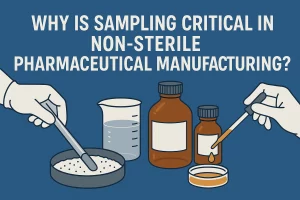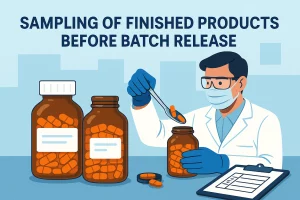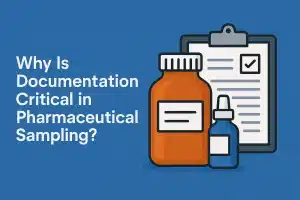
In the pharmaceutical industry, sampling is far more than a routine task , it’s a frontline defense against contamination, formulation errors, and regulatory setbacks. When dealing with non-sterile pharmaceutical products, manufacturers rely heavily on sampling procedures to confirm that each dosage form meets safety and quality standards. Whether you’re handling powders, tablets, or liquids, drawing a representative sample at each stage of the manufacturing process provides real-time validation of batch integrity.
For non-sterile products, the risk isn’t necessarily about sterility but about ensuring that microorganisms present fall within acceptable thresholds. Improperly executed sampling methods can fail to catch microbial hotspots, chemical degradation, or even mix-ups in raw material, any of which can compromise the finished drug product. That’s why cGMP guidelines emphasize the strategic importance of well-documented, scientifically justified sampling plans.
What Makes a Sampling Procedure GMP-Compliant?
A compliant sampling procedure begins with written SOPs that outline the exact steps to be followed , from how the sample was taken, to the equipment used, environmental controls, and the handling of sample containers. According to PIC/S and FDA cGMP guidance, documentation must include the date of sampling, lot number, sampling method, and the containers from which samples are drawn.
To meet GMP expectations, the procedure must also define the quantity of sample required, use clean sampling tools like a spatula or pipette, and ensure the sample is handled in a way that avoids contamination. Sampling under aseptic conditions is not mandatory for non-sterile dosage forms, but cross-contamination must be tightly controlled. Furthermore, samples should be stored in proper amber glass or plastic bottles that prevent degradation and ensure traceability throughout the quality control cycle.
How Are Samples Collected from Raw Materials?
Sampling of raw materials is the first checkpoint in ensuring the quality of pharmaceutical products. This includes active pharmaceutical ingredients (APIs), excipients, and even packaging materials such as cartons and labels. The goal is to verify identity, purity, and microbial quality before materials move downstream in the manufacturing process.
To avoid microbial contamination, samples are drawn using sterile or disinfected sampling tools like thieves, pipettes, or spatulas, depending on the material’s physical form (powder, liquid, or solid). For critical materials, GMP guidelines recommend sampling every container, while for validated suppliers, a statistically justified number may be sufficient. Proper labeling of the sample containers with the lot number, material name, and date of sampling is mandatory for traceability.
Typical practices include:
- For powders: Insert a thief at different levels (top, middle, bottom) to form a composite sample.
- For liquids: Use a sterile pipette, disinfect the container opening, and collect into amber glass bottles.
- For microbiological testing: Use sterile, disposable containers and transfer samples inside a controlled environment.
What Microbiological Tests Are Performed on Non-Sterile Samples?
Unlike sterile products, non-sterile pharmaceutical products are not tested for complete sterility, but they must meet defined limits for microorganisms present. These include both enumeration tests and specified microorganism detection. The purpose is to ensure that any microbiological presence in the drug product does not compromise patient safety based on the route of administration.
Pharmaceutical microbiology protocols dictate that non-sterile samples be tested using methods like membrane filtration, plate count on Sabouraud Dextrose Agar or Tryptic Soy Agar, and incubation under controlled conditions. Products intended for oral, topical, or inhalation use have different acceptance thresholds based on ISO and pharmacopeial standards.
Key tests include:
- Total aerobic microbial count (TAMC)
- Total yeast and mold count (TYMC)
- Absence of specified microorganisms such as E. coli, Salmonella, Pseudomonas aeruginosa, and Staphylococcus aureus
The microbiological quality of non-sterile drug products is thus confirmed not by achieving zero contamination, but by proving that microorganisms in the presence of the product remain within acceptable safety margins.
What Sampling Methods Are Commonly Used in the Pharmaceutical Industry?
To ensure representativeness and regulatory compliance, the pharmaceutical industry employs a variety of sampling methods, depending on material type, processing stage, and risk profile. Each sampling procedure must be documented and executed in accordance with GMP.
Common sampling methods include:
- Random Sampling: Often used for bulk raw materials or finished goods to avoid selection bias. Ensures each unit has an equal chance of being selected.
- Stratified Sampling: Applied when batches are divided into sub-groups (e.g., pallets or containers). Samples are collected proportionally from each stratum.
- Composite Sampling: Individual samples from multiple units are combined into one composite sample for testing. Ideal for microbiological or chemical analysis when the material is expected to be uniform.
- Systematic Sampling: Involves selecting every nth unit or container based on a defined interval. Used in product testing of packaging or finished drug forms.
The sampling plan and method must match the material characteristics and intended use. For example, non-sterile dosage forms like tablet blends or powders from drums require multi-level sampling using a thief, while liquids call for sterile transfer tools and closed-system access points.
How Are Finished Products Sampled Before Batch Release?
Before any finished product is released, representative samples must be taken to validate compliance with quality control standards. This process confirms that the drug product meets potency, purity, identity, and microbial limits, as outlined in the product specification.

The sampling procedure for non-sterile pharmaceutical products often follows ISO 2859 standards, defining the number of containers to be tested based on batch size and acceptance criteria. In some cases, sampling is done both at the beginning and end of filling lines, especially for tablet or capsule forms, to detect process variation.
Retention samples are also taken and stored under recommended conditions for stability and traceability. These are essential for future investigations in case of a complaint or recall.
Key considerations include:
- Correct labeling: Must include batch number, lot number, and sampling position (e.g., top, middle, bottom).
- Documentation: All sample movements must be logged by the quality assurance or control laboratory.
- Environment: Sampling should occur under controlled conditions to avoid microbial contamination or mix-ups.
How Are Starting Materials Sampled According to GMP?
In pharmaceutical manufacturing, the sampling procedure for starting materials like raw material, excipient, and active pharmaceutical ingredients is critical. According to GMP and PIC/S guidelines, samples must be taken in a way that ensures they represent the entire batch. For sensitive materials, this often means sampling from every container, especially when dealing with APIs or ingredients used in non-sterile drug products.
The identity of the sampled material must be verified, and the sample containers clearly labeled with essential data: including the batch number, date of sampling, and containers from which samples were drawn. When the same supplier has a well-established quality record, reduced sampling (e.g., based on risk assessment) may be accepted, but always with documented justification.
Microbiological testing may also be required for certain starting materials. In such cases, sterile sampling techniques and containers must be used. The risk of microbial contamination is particularly high during this phase, especially with powders or moisture-sensitive substances. Every effort must be made to maintain sample integrity throughout.
What Role Does Microbiological Testing Play in Sampling Non-Sterile Products?
Microbiological testing is a cornerstone of ensuring the microbiological quality of non-sterile pharmaceutical products. Even if the dosage form does not require sterility, it must be tested for the absence or limits of specified microorganisms, depending on the route of administration. For instance, oral tablet forms have different requirements than topical creams.
Testing procedures involve enumeration tests using culture media like sabouraud dextrose agar or tryptic soy agar to detect total aerobic microbial count and yeast/mold count. The samples must be collected aseptically and incubated under defined conditions to reveal any microorganisms present.
Environmental controls and proper handling of sampling tools, such as pipette, spatula, or scoop, are also crucial. Aseptic conditions may not be mandatory, but any lapse during sampling procedure can lead to microorganisms in the presence of the product, potentially compromising safety and quality. This is especially important in products intended for children, immunocompromised individuals, or those applied to mucous membranes.
How Should Sampling of Packaging Materials Be Handled?
Packaging materials play a direct role in protecting the finished drug product and preserving its safety and quality. As per GMP standards, the sampling procedure for packaging components such as cartons, labels, and blister foils must ensure both identification and traceability. These materials are typically not sampled for microbial content but for correct labeling, legibility, and conformance to specifications.
Every sample must be clearly marked with relevant details: lot number, supplier name, date of sampling, and the quantity sampled. The original sample must be retained as a retention sample for future reference. Errors at this stage, like mismatched batch numbers or outdated artwork, can lead to relabeling failures, product recalls, or worse, harm to patients. For this reason, quality assurance often maintains a sample register to store updated reference samples of all packaging elements.
The goal is not just regulatory compliance but visual and functional consistency across all drug product units. Regular updates to the sampling plan, particularly after packaging updates or supplier changes, are key to avoiding costly contamination or mislabeling issues.
What Are the Most Common Sampling Techniques in the Pharmaceutical Industry?
The pharmaceutical industry relies on various sampling techniques to collect representative portions of raw materials, non-sterile dosage forms, and finished batches. The choice of sampling method depends on the material type, container configuration, and sampling tools available.
For powders, a multicompartmental thief or scoop is used to collect samples from the top, middle, and bottom of a drum. This helps detect stratification or segregation. For liquids, pipettes or sampling valves are employed, especially for in-process tanks or light-sensitive suspensions. Solid dosage forms like tablets and capsules are sampled by hand using clean gloves, ensuring coverage across the entire run (e.g., beginning, middle, and end).
Regardless of the tool, the sample was taken must be transferred into pre-labeled sample containers, ideally amber glass or sterile plastic depending on the analysis type. Poor technique, like improper cleaning of sampling tools, can result in microbial contamination, compromised potency readings, or non-representative data that misguides batch release decisions.
Why Is Documentation Critical in Pharmaceutical Sampling?
In pharmaceutical manufacturing, the importance of proper documentation cannot be overstated. Every sampling procedure must be traceable from start to finish to comply with GMP standards and ensure the integrity of the finished drug product. Regulatory bodies like the FDA and EMA expect detailed records of what sample was taken, from which containers, using which tools, under what conditions, and by whom.

Labels must include the batch number, lot number, date of sampling, and the identity of the sampler. Logbooks or digital records should also track cleaning and calibration of sampling tools, including pipettes, spatulas, or thieves, especially if those tools are reused. Failing to document even a minor step could raise red flags during an audit or compromise process validation outcomes.
Good documentation isn’t just for auditors. It also supports quality control, aids in root cause investigations, and minimizes the risk of overlooking a microbiological or chemical deviation, especially in non-sterile pharmaceutical products, where cross-contamination is harder to eliminate.
What Microbiological Considerations Apply to Non-Sterile Sampling?
While non-sterile products don’t require the same level of aseptic conditions as sterile ones, they are still subject to rigorous microbiological quality standards. According to guidelines like USP <61> and <62>, the microbiological burden of non-sterile pharmaceutical products must be controlled and tested for the absence of specified microorganisms, such as Escherichia coli, Salmonella spp., and Staphylococcus aureus.
Microbiological testing usually begins with proper sample collection using sterile sampling tools. This includes sterile pipettes, bottles, and gloves. The sampling procedure should prevent the introduction of microorganisms present in the environment, which could compromise test results.
Collected samples are typically placed in or onto Sabouraud dextrose agar, nutrient agar, or selective media, depending on the dosage form and testing requirements. These samples are then incubated under defined conditions to allow for enumeration tests and identification of microorganisms in the presence of pharmaceutical compounds. Even though the route of administration may not require sterility, excessive microbial load can still compromise product safety and shelf life.
When Is Re-Sampling Justified?
Re-sampling in pharmaceutical environments must follow strict controls. It’s only justified under specific conditions such as when the original sample is compromised, insufficient, or fails due to sampling error, not product quality. Re-sampling can never be used to “overturn” a failed result unless it’s linked to an issue in the sampling procedure itself.
Each re-sampling event must be authorized by quality assurance and fully documented, including the reason, sampling tools used, and exact containers from which samples are taken. This ensures traceability and avoids introducing bias into the product testing process.
What Role Do Sampling Plans Play in Product Quality?
A structured sampling plan is the backbone of statistically valid sample collection. According to ISO 2859, choosing the right plan (e.g., acceptance, stratified, or composite sample) depends on the manufacturing process, product type, and acceptable microbiological or physical contamination risk.
Manufacturers use plans that balance detection power with resource efficiency. For example:
- Attribute plans work for binary outcomes (pass/fail)
- Variable plans are ideal for continuous data like potency
- Composite sampling saves time when uniformity is expected but must still trace back to each container
Without a sound sampling plan, it’s impossible to draw reliable conclusions about non-sterile drug products and their dosage form quality.
Conclusion
To ensure safety and quality in non-sterile pharmaceutical products, sampling isn’t just a formality, it’s a controlled, strategic process grounded in science, statistics, and GMP regulation. Whether you’re testing starting materials, packaging materials, or a finished product, the sampling procedure must minimize contamination, ensure traceability, and follow validated methods.
Poor technique or documentation can lead to false results, microbial contamination, costly recalls, or even regulatory shutdowns. But when done right, sampling supports product consistency, quality control, and pharmaceutical microbiology standards.
